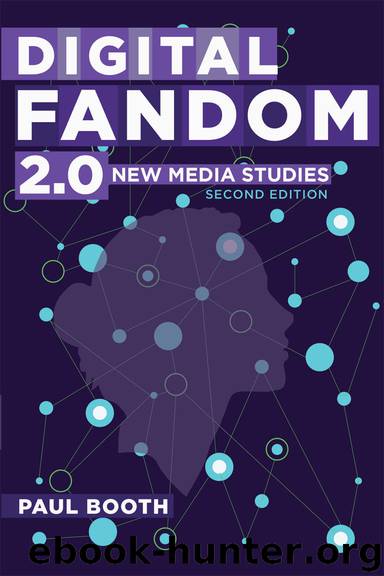Digital Fandom 2.0: New Media Studies (Digital Formations) by Paul Booth

Author:Paul Booth [Booth, Paul]
Language: eng
Format: azw3
Publisher: Peter Lang
Published: 2017-03-27T04:00:00+00:00
Reconstruction through Branched Narratives
A second way scholars can use an interreal analysis is by examining the reconstruction of extant media objects on MySpace. Fans identify more readily with characters through interacting with extant media objects, as Ng shows: Creating fan fiction or fan videos creates an “experience that cannot be derived from watching the show.”76 MySpace offers fans a space in which they can reproduce characters and situations from the extant media object, and then use those characters to reproduce fan culture. Through imaginative dialogue, the rewriting of characteristics seen on the television show, or reliving the narrative events that have been most dramatic, the fan encounters the extant media object’s narrative as a mutable text. This mutability is what Jenkins calls the “silly-putty” of the story: Fans end up “stretching [the extant media object’s] boundaries to incorporate their concerns, remolding its characters to better suit their desires.”77 Each fan-created character persona becomes a way of both reliving and altering the extant media object’s narrative text, opening up new possibilities by recreating those that have already occurred onscreen.
This method of identity roleplay on MySpace occurs through the interaction between narrative elements on the page. One’s persona fits within the social framework produced by the fan community on MySpace. As van ← 134 | 135 → Kokswijk shows, virtual identity is not just defined as the place, but also the “plot you are in.”78 Plot, here, can mean two things: either a plot of land (i.e., the space you construct online) or a “plot” of a narrative (i.e., the narrative you create for yourself online). Thus, an extant media character’s persona provides both a space and a narrative framework around which fan personas can extend narrative possibilities.
We can see this narrative dimension in the way the character persona of gwencooper, another profile of the character Gwen Cooper from the television show Torchwood, describes herself in the “About Me” section on her MySpace persona.79 Gwencooper first uses this space to define her persona, (re)writing “My story starts off with me as a police officer in Cardiff but then i get involved in the Torchwood team [all sic].” In this statement, the writer of gwencooper has described the extant media character as media producers and the actress have made her on the show—this is, therefore, a diegetic description, or one that repeats narrative/character information we already know from the canon of the extant media object. This is an aspect of the character’s persona.
The “About Me” goes on, however, to rewrite Torchwood: “I’m a very down-to-earth girl, kind and generous, but extremely ambitious, feisty, intelligent and witty, if i do say so myself. But im really the girl next door [all sic].” These characteristics do not all diegetically describe the character of Gwen Cooper from Torchwood. Instead, these characteristics point to an amalgam identity, one created in an interreality by adding aspects to the diegesis of the narrative. The insertion of alternative narrative elements into a fan’s rewritten version of an extant media object
Download
This site does not store any files on its server. We only index and link to content provided by other sites. Please contact the content providers to delete copyright contents if any and email us, we'll remove relevant links or contents immediately.
| Automotive | Engineering |
| Transportation |
Whiskies Galore by Ian Buxton(41879)
Introduction to Aircraft Design (Cambridge Aerospace Series) by John P. Fielding(33064)
Small Unmanned Fixed-wing Aircraft Design by Andrew J. Keane Andras Sobester James P. Scanlan & András Sóbester & James P. Scanlan(32743)
Craft Beer for the Homebrewer by Michael Agnew(18140)
Turbulence by E. J. Noyes(7936)
The Complete Stick Figure Physics Tutorials by Allen Sarah(7307)
Kaplan MCAT General Chemistry Review by Kaplan(6867)
The Thirst by Nesbo Jo(6828)
Bad Blood by John Carreyrou(6552)
Modelling of Convective Heat and Mass Transfer in Rotating Flows by Igor V. Shevchuk(6391)
Learning SQL by Alan Beaulieu(6211)
Weapons of Math Destruction by Cathy O'Neil(6146)
Man-made Catastrophes and Risk Information Concealment by Dmitry Chernov & Didier Sornette(5921)
Digital Minimalism by Cal Newport;(5664)
Life 3.0: Being Human in the Age of Artificial Intelligence by Tegmark Max(5474)
iGen by Jean M. Twenge(5366)
Secrets of Antigravity Propulsion: Tesla, UFOs, and Classified Aerospace Technology by Ph.D. Paul A. Laviolette(5309)
Design of Trajectory Optimization Approach for Space Maneuver Vehicle Skip Entry Problems by Runqi Chai & Al Savvaris & Antonios Tsourdos & Senchun Chai(5011)
Pale Blue Dot by Carl Sagan(4912)
